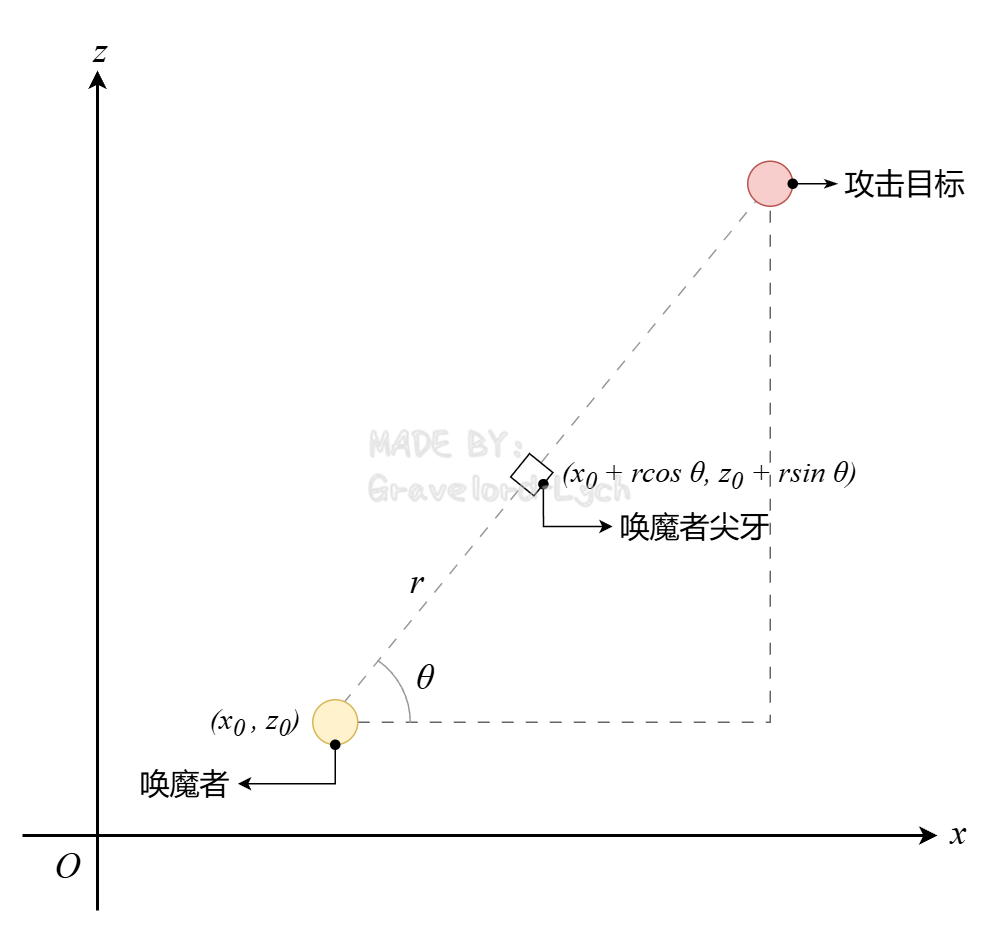唤魔者的三大魔法
唤魔者会使用的法术共分为3种,可以用以下的表格来简单概括:
| 施法AI类名 | 作用 | 优先级 | 准备时间 | 总用时 | 冷却时间 |
|---|---|---|---|---|---|
EvokerSummonSpellGoal |
召唤恼鬼 | 4 | 20 | 40 | 340 |
EvokerAttackSpellGoal |
召唤唤魔者尖牙 | 5 | 20 | 100 | 100 |
EvokerWololoSpellGoal |
把蓝色绵羊变成红色 | 6 | 40 | 60 | 140 |
注:
- 上表中所有时间的单位均为tick
- 优先级:数字越低,优先级越高,当多个AI冷却完毕时,高优先级的AI优先执行
- 准备时间:即
getCastWarmupTime返回值,原版中该方法总是返回常数 - 总用时:即
getCastingTime返回值,原版中该方法总是返回常数 - 冷却时间:即
getCastingInterval返回值,原版中该方法总是返回常数
上一节中讲过SpellcasterUseSpellGoal,其中的canUse方法保证施法AI之间是互斥的,因此同一时刻只会执行一个施法AI,且优先级高的施法AI先执行。
接下来具体分析每一种AI时,为了避免文章冗余,笔者将会只分析除getCastWarmupTime、getCastingTime与getCastingInterval外的,对施法AI的底层实现有重要意义的方法。
召唤恼鬼(EvokerSummonSpellGoal)
这是个“很不受玩家喜欢”的法术,但是这也是底层逻辑十分简单的法术~
唤魔者只会在自身碰撞箱向6个方向扩展16格后形成的长方体内恼鬼数量小于8时召唤恼鬼,且四周的恼鬼越多,使用该法术的概率越小。
@Override
public boolean canUse() {
if (!super.canUse()) {
return false;
} else {
int i = level().getNearbyEntities(Vex.class, vexCountTargeting, Evoker.this, getBoundingBox().inflate(16.0D)).size();
return random.nextInt(8) + 1 > i;
}
}
然后是performSpellCasting。该方法会在唤魔者四周固定生成3只恼鬼。
@Override
protected void performSpellCasting() {
ServerLevel serverLevel = (ServerLevel) level();
for (int i = 0; i < 3; ++i) {
// 选取自身四周的随机位置,注意召唤出的恼鬼的y坐标永远是唤魔者的y坐标+1
BlockPos pos = blockPosition().offset(-2 + random.nextInt(5), 1, -2 + random.nextInt(5));
Vex vex = EntityType.VEX.create(level());
if (vex != null) { // 这里有个null-check,是因为EntityTyoe的create方法是@Nullable的。不过绝大多数情况下create方法都不会返回null
vex.moveTo(pos, 0.0F, 0.0F);
vex.finalizeSpawn(serverLevel, level().getCurrentDifficultyAt(pos), MobSpawnType.MOB_SUMMONED, null, null);
vex.setOwner(Evoker.this);
// 限制恼鬼的活动范围
vex.setBoundOrigin(pos);
// 使恼鬼在一定时间后不断受到伤害
vex.setLimitedLife(20 * (30 + random.nextInt(90)));
serverLevel.addFreshEntityWithPassengers(vex);
}
}
}
把蓝色绵羊变成红色(EvokerWololoSpellGoal)
这个法术本身也很简单,只是canUse比较复杂而已。
@Override
public boolean canUse() {
// 显然唤魔者在战斗的时候没有闲心调教绵羊
if (getTarget() != null) {
return false;
} else if (isCastingSpell()) {
return false;
}
// 这个AI彻底重写了canUse方法,所以要重新判断法术是否在冷却
else if (tickCount < nextAttackTickCount) {
return false;
}
// 再次提醒读者不要忘记确认GameRule是否允许实体的行为
else if (!ForgeEventFactory.getMobGriefingEvent(level(), Evoker.this)) {
return false;
}
else {
List<Sheep> list = level().getNearbyEntities(Sheep.class, wololoTargeting, Evoker.this, getBoundingBox().inflate(16.0D, 4.0D, 16.0D));
if (list.isEmpty()) {
return false;
} else {
// wololoTarget和target是独立的,因此不能替换为setTarget
setWololoTarget(list.get(random.nextInt(list.size())));
return true;
}
}
}
@Override
public boolean canContinueToUse() {
return getWololoTarget() != null && attackWarmupDelay > 0;
}
performSpellCasting中简单地改变了绵羊的颜色。
@Override
protected void performSpellCasting() {
Sheep sheep = Evoker.this.getWololoTarget();
if (sheep != null && sheep.isAlive()) {
sheep.setColor(DyeColor.RED);
}
}
最后不要忘了重置wololoTarget。
@Override
public void stop() {
super.stop();
Evoker.this.setWololoTarget((Sheep)null);
}
召唤唤魔者尖牙(EvokerAttackSpellGoal)
这看上去是唤魔者使用的最朴素的法术,可其实这个法术在“代码意义”上才是最复杂的法术。复杂就复杂在尖牙的位置的确定。
先考虑单个水平位置(x与z)已被确定的尖牙。尖牙的y坐标是如何确定的呢?读者可能会认为,使用地面的y坐标值不就行了吗?但问题是哪里才是所谓的“地面”呢?
回顾1.2.1.3.2中提到的找y坐标的方式:用MutableBlockPos调整或通过Heightmap获取。如果借助高度图(Heightmap)获取,显然因为这种方式因为通过获取水平位置上固体方块的最大y坐标值来确定坐标,所以在室内环境等环境下并不适用。
所以只能采用前一种方式,不断检查尖牙生成位置并以此调整y坐标。原版的实现中没有使用MutableBlockPos,但是思想是一样的。原版对一定y坐标范围内的方块进行了检查,如果检测到合适的可生成尖牙的位置就生成尖牙。
// warmupDelayTicks是尖牙出现的额外的延迟时间,算上施法本身的准备时间,在tps为20的情况下,一个warmupDelayTicks为5的尖牙会在从唤魔者举起手开始1.25s后出现
private void createSpellEntity(double x, double z, double minY, double maxY, float rotation, int warmupDelayTicks) {
BlockPos pos = BlockPos.containing(x, maxY, z);
boolean foundSuitablePos = false;
double dy = 0.0D;
do {
BlockPos belowPos = pos.below();
BlockState belowState = level().getBlockState(belowPos);
// 检查该位置下方的方块是否能够为该位置的方块提供SupportType.FULL,用于检查该位置方块是否“不透明”。
if (belowState.isFaceSturdy(level(), belowPos, Direction.UP)) {
if (!level().isEmptyBlock(pos)) {
BlockState state = level().getBlockState(pos);
VoxelShape shape = state.getCollisionShape(level(), pos);
if (!shape.isEmpty()) {
dy = shape.max(Direction.Axis.Y);
}
}
foundSuitablePos = true;
break;
}
pos = pos.below();
} while (pos.getY() >= Mth.floor(minY) - 1);
if (foundSuitablePos) {
level().addFreshEntity(new EvokerFangs(level(), x, (double) pos.getY() + dy, z, rotation, warmupDelayTicks, Evoker.this));
}
}
附上Wiki的描述:尖牙只会生成在不低于位置最低的目标的脚、不高于位置最高的目标的脚上方1格的位置。尖牙会尝试在这一区域的不透明方块上生成,但当这个方块被固体方块挡住时会生成失败。这意味着召唤的尖牙无法生成在深坑里或高墙顶,但如果唤魔者在深坑的底部而目标在上方,它会试图走到顶部以发动攻击,反之亦然。
然后考虑尖牙水平位置的确定。水平位置的确定则比较简单,只要进行一些三角函数的运算就可以了。
下图展示了唤魔者尖牙的水平位置的大致确定方式。

以及相关的代码。
@Override
protected void performSpellCasting() {
LivingEntity target = getTarget();
double minY = Math.min(target.getY(), getY());
double maxY = Math.max(target.getY(), getY()) + 1.0D;
float facingAngle = (float) Mth.atan2(target.getZ() - getZ(), target.getX() - getX());
// 对距离较近的目标:召唤两圈尖牙
if (distanceToSqr(target) < 9.0D) {
for (int i = 0; i < 5; ++i) {
float rotation = facingAngle + (float) i * (float) Math.PI * 0.4F;
createSpellEntity(getX() + (double) Mth.cos(rotation) * 1.5D, getZ() + (double) Mth.sin(rotation) * 1.5D, minY, maxY, rotation, 0);
}
for (int k = 0; k < 8; ++k) {
// 注:1.2566371F = Math.PI * 0.4F
float rotation = facingAngle + (float) k * (float) Math.PI * 2.0F / 8.0F + 1.2566371F;
createSpellEntity(getX() + (double) Mth.cos(rotation) * 2.5D, getZ() + (double) Mth.sin(rotation) * 2.5D, minY, maxY, rotation, 3);
}
}
// 对距离较远的目标:召唤一排尖牙
else {
for (int l = 0; l < 16; ++l) {
double distanceToSelf = 1.25D * (double) (l + 1);
int warmupDelayTicks = 1 * l;
createSpellEntity(getX() + (double) Mth.cos(facingAngle) * distanceToSelf, getZ() + (double) Mth.sin(facingAngle) * distanceToSelf, minY, maxY, facingAngle, warmupDelayTicks);
}
}
}
那么唤魔者的逻辑部分到这里就结束了,接下来则是唤魔者的渲染部分。